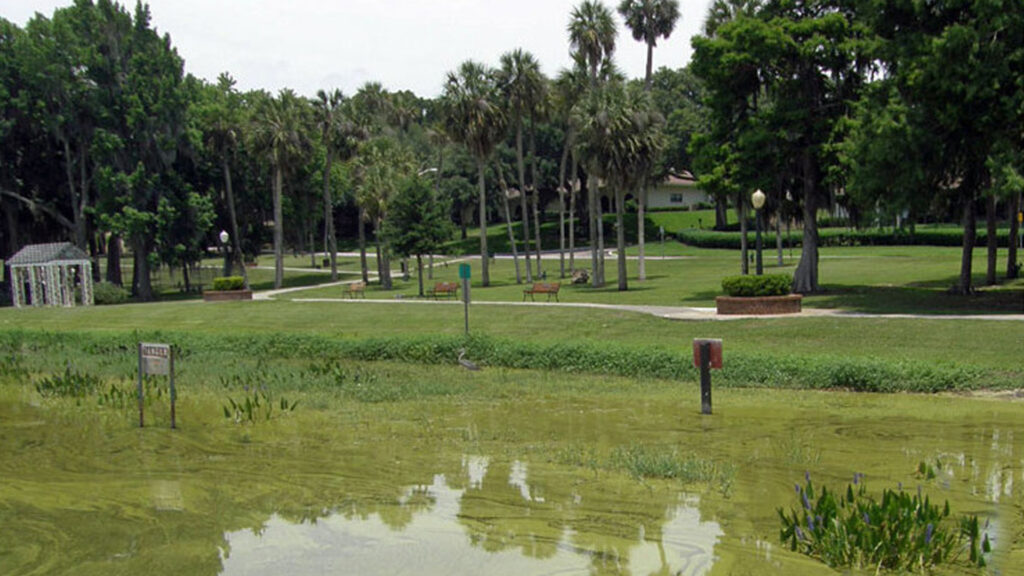By Mia McCormick, Environment Florida
Those who live, work and play in Sarasota are holding their breath as millions of gallons of sewage spilled during Tropical Storm Debby clears the bay. Just north in Tampa Bay, another 6.3 million gallons of sewage mixed into bay water due to excessive rain and flooding
It’s not the smell that has people waiting to exhale, although in some places it’s putrid, it’s that they know this disaster is not over yet. Wastewater spills contain a significant amount of nitrogen and/or phosphorus, two key drivers of toxic algae outbreaks often called harmful algal blooms.
We are familiar with algal blooms
Florida is no stranger to harmful algal blooms. Red tide has plagued our beaches, blue-green algae has killed our seagrass and many ponds and waterways are covered in algae that looks like a green scum this time of year. People living near Piney Point in Manatee County can tell stories of evacuations and mounds of dead wildlife from hundreds of millions of gallons of toxic wastewater spilled from the now shuttered phosphorus facility.

Floridians who live and work along the Caloosahatchee River and are fed up with Lake Okeechobee’s discharges polluted by runoff from nearby farms turning the waters a sickly shade of green, blocking out sunlight to the seagrass below and stinking up the banks. Manure and runoff from animal processing plants are another large source of pollution that can cause algae to grow rapidly.
If you live here, you’ve probably heard of toxic algae, but in case you haven’t, a great explainer on what can cause an outbreak and how it affects humans, pets and wildlife can be found at https://bit.ly/allaboutalgaeblooms. In short, it’s all bad.
A big part of finding solutions to the problem is understanding the cause and consequences of these blooms. Sometimes, like in the case of Debby, the source may seem clear. Aging and failing wastewater infrastructure was overwhelmed and dumped a ton of fuel into our west coast estuaries for algae to feast on.
Combined with warm water temperatures it makes the perfect soup for a feeding frenzy. That’s why much of Florida’s central west coast is sitting on pins and needles, worrying a major bloom is in the making. But in the case of runoff, the source of the pollution may not be clear.
Research and data can lead to solutions
It’s heartening to see some measures taking place to better understand these blooms, like the Harmful Algal Bloom and Hypoxia Research and Control Amendments Act of 2023. The idea is that comprehensive research will allow leaders at the city, state and federal levels to take action to address the problems that cause the blooms.

For example, more than $100 million was designated to find and replace leaky septic tanks that were draining into the Indian River Lagoon on Florida’s east coast. This was in response to a mass manatee die off in 2021 when harmful algal blooms killed much of the seaweed these gentle giants feed on.
As the bill continues to gain strong bipartisan support and make its way through committees, we encourage our members of Congress from Florida to co-sponsor it. The bill moved favorably through the Committee on Commerce, Science and Transportation at the end of last month.
While this bill isn’t going to fix the problem, the research could help us advocate for real solutions.
Mia McCormick is an advocate with Environment Florida, a policy and action group with one mission: to build a healthier, greener Sunshine State. This piece was originally published at https://environmentamerica.org/florida/articles/living-with-the-threat-of-a-toxic-algal-bloom/.
If you are interested in submitting an opinion piece to The Invading Sea, email Editor Nathan Crabbe at nc*****@*au.edu. Sign up for The Invading Sea newsletter by visiting here. To learn more about harmful algal blooms, watch the video below.



